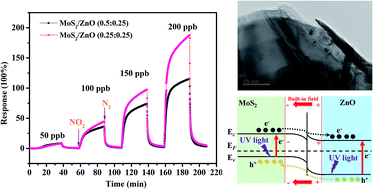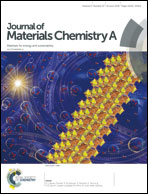UV assisted ultrasensitive trace NO2 gas sensing based on few-layer MoS2 nanosheet–ZnO nanowire heterojunctions at room temperature†
Abstract
Nitrogen dioxide (NO2) is a hazardous gas species that could impose a great threat on environmental protection and human health even at very low doses. Thus, it is of great importance to selectively detect trace NO2 gas below the ppm level. This has been a serious challenge so far, especially in the presence of other interfering gases. Herein, we report ultrasensitive, room-temperature and UV light-assisted NO2 gas sensing based on few-layer MoS2 nanosheet/ZnO nanowire composites serving as the sensing layer. A series of characterization techniques, such as scanning electron microscopy (SEM), transmission electron microscopy (TEM), X-ray photoelectron spectroscopy (XPS), X-ray powder diffraction (XRD), Raman, energy-dispersive X-ray spectroscopy (EDS), UV-Visual and ultraviolet photoelectron spectroscopy (UPS), were employed to explore the componential and structural properties of the obtained sensitive materials. Initially, the as-prepared MoS2/ZnO composites showed a tiny response (40%) and an incomplete recovery to 10 ppm NO2 gas in dark condition. While under UV illumination, the sensing response attained 8.4 and 188, toward 50 ppb and 200 ppb NO2 with a full recovery. Meanwhile, a sensitivity of 0.93 ppb−1, a detection limit of 50 ppq (10−15), and excellent repeatability and selectivity were also achieved. The experimental results were better than most previous work on NO2 detection to the best of our knowledge. Two main aspects are responsible for the outstanding performance. One is that a mass of photo-excited electron–hole pairs participated in the reaction with NO2 molecules under UV illumination. The other lies in numerous p–n MoS2/ZnO nanojunctions, favorable for the extension of the depletion region and the separation of the charge carrier. Additionally, long-term stability, as well as the effect of film thickness and carrier gas species on sensor performance, were simply investigated. We combined p–n nanojunctions with the UV illumination method, providing an alternative strategy to realize room-temperature operation and high sensitivity in the field of gas sensors.



 Please wait while we load your content...
Please wait while we load your content...